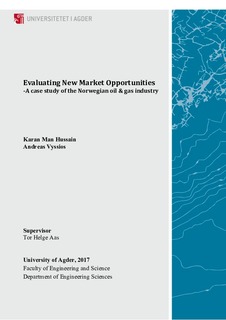| dc.contributor.author | Hussain, Karan Man | |
| dc.contributor.author | Vyssios, Andreas | |
| dc.date.accessioned | 2017-09-18T10:04:57Z | |
| dc.date.available | 2017-09-18T10:04:57Z | |
| dc.date.issued | 2017 | |
| dc.identifier.uri | http://hdl.handle.net/11250/2455066 | |
| dc.description | Master's thesis Industrial Economics and Technology Management - University of Agder 2017 | nb_NO |
| dc.description.abstract | The objective for this thesis is to examine the composition of internal and external factors
that shape the industry, and how such a combination can benefit firms in seeking potential
markets. To answer this combination this thesis proposes a tool, EPM (Evaluation of Potential
Markets). This tool offers a structured approach to evaluate new market opportunities, and
seeks to determine the source of competitive advantage on the basis of fundamentals from two
dominant theories within strategic management: Resource-based view of the firm (RBV) and
Porter’s industry analysis.
EPM is assigned to a case study, presented by oil and gas firms in the Southern part of
Norway. This case is presented by GCE NODE, a business cluster comprised of 72 companies
in the Southern part of Norway. The case study attempts to seek out the sources of competitive
advantage within these firms and apply them to a new potential market, aquaculture. The study
embraces a qualitative research method, where selection consisting of firms and clusters from
both aquaculture and oil and gas, constitutes to the interviews, which is the main source of data
collection.
Findings show, that a composition of contradicting perspectives regarding both firm- and
industry specific factors complement each other, while providing valuable insights and analysis
regarding competitive advantage. Findings provide a better understanding of where it excels
and its shortcomings, and how it can be improved to something that can be applied in a
professional environment. The shortcomings of EPM are in regards to its applicability, content
and presentation. For EPM to be a tool that can answer the requirements of business
communities, it must be improved in cooperation with the firms themselves. While not able to
provide as much specificity and depth in terms of resources as intended, the analysis did
uncover sufficient strategic impacts for firms to consider opportunities in new markets | nb_NO |
| dc.language.iso | eng | nb_NO |
| dc.publisher | Universitetet i Agder ; University of Agder | nb_NO |
| dc.rights | Attribution-NonCommercial-NoDerivatives 4.0 Internasjonal | * |
| dc.rights.uri | http://creativecommons.org/licenses/by-nc-nd/4.0/deed.no | * |
| dc.subject | IND590 | nb_NO |
| dc.title | Evaluating New Market Opportunities : A case study of the Norwegian oil & gas industry | nb_NO |
| dc.type | Master thesis | nb_NO |
| dc.subject.nsi | VDP::Samfunnsvitenskap: 200::Økonomi: 210 | nb_NO |
| dc.subject.nsi | VDP::Samfunnsvitenskap: 200::Statsvitenskap og organisasjonsteori: 240::Offentlig og privat administrasjon: 242 | nb_NO |
| dc.source.issue | V, 71 p. | nb_NO |

